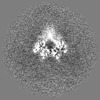+ Open data
Open data
- Basic information
Basic information
| Entry | Database: EMDB / ID: EMD-20541 | |||||||||
|---|---|---|---|---|---|---|---|---|---|---|
| Title | CryoEM map of NA-80 Fab in complex with N9 Shangahi2 | |||||||||
 Map data Map data | CryoEM map of NA-80 Fab in complex with N9 Shanghai | |||||||||
 Sample Sample |
| |||||||||
 Keywords Keywords | Neuraminidase / NA / Sh2 / N9Shanghai / N9Sh2 / antibody / Fab / NA-80 / Influenza / VIRAL PROTEIN-IMMUNE SYSTEM complex / H7N9 | |||||||||
| Function / homology |  Function and homology information Function and homology informationexo-alpha-sialidase / exo-alpha-sialidase activity / viral budding from plasma membrane / carbohydrate metabolic process / host cell plasma membrane / virion membrane / metal ion binding / membrane Similarity search - Function | |||||||||
| Biological species |  Influenza A virus (A/environment/Shanghai/S1439/2013(H7N9)) / Influenza A virus (A/environment/Shanghai/S1439/2013(H7N9)) /  Homo sapiens (human) Homo sapiens (human) | |||||||||
| Method | single particle reconstruction / cryo EM / Resolution: 3.6 Å | |||||||||
 Authors Authors | Ward AB / Turner HL | |||||||||
| Funding support |  United States, 2 items United States, 2 items
| |||||||||
 Citation Citation |  Journal: Cell Host Microbe / Year: 2019 Journal: Cell Host Microbe / Year: 2019Title: Structural Basis of Protection against H7N9 Influenza Virus by Human Anti-N9 Neuraminidase Antibodies. Authors: Xueyong Zhu / Hannah L Turner / Shanshan Lang / Ryan McBride / Sandhya Bangaru / Iuliia M Gilchuk / Wenli Yu / James C Paulson / James E Crowe / Andrew B Ward / Ian A Wilson /  Abstract: Influenza virus neuraminidase (NA) is a major target for small-molecule antiviral drugs. Antibodies targeting the NA surface antigen could also inhibit virus entry and egress to provide host ...Influenza virus neuraminidase (NA) is a major target for small-molecule antiviral drugs. Antibodies targeting the NA surface antigen could also inhibit virus entry and egress to provide host protection. However, our understanding of the nature and range of target epitopes is limited because of a lack of human antibody structures with influenza neuraminidase. Here, we describe crystal and cryogenic electron microscopy (cryo-EM) structures of NAs from human-infecting avian H7N9 viruses in complex with five human anti-N9 antibodies, systematically defining several antigenic sites and antibody epitope footprints. These antibodies either fully or partially block the NA active site or bind to epitopes distant from the active site while still showing neuraminidase inhibition. The inhibition of antibodies to NAs was further analyzed by glycan array and solution-based NA activity assays. Together, these structural studies provide insights into protection by anti-NA antibodies and templates for the development of NA-based influenza virus vaccines and therapeutics. | |||||||||
| History |
|
- Structure visualization
Structure visualization
| Movie |
 Movie viewer Movie viewer |
|---|---|
| Structure viewer | EM map:  SurfView SurfView Molmil Molmil Jmol/JSmol Jmol/JSmol |
| Supplemental images |
- Downloads & links
Downloads & links
-EMDB archive
| Map data |  emd_20541.map.gz emd_20541.map.gz | 85.9 MB |  EMDB map data format EMDB map data format | |
|---|---|---|---|---|
| Header (meta data) |  emd-20541-v30.xml emd-20541-v30.xml emd-20541.xml emd-20541.xml | 20.3 KB 20.3 KB | Display Display |  EMDB header EMDB header |
| FSC (resolution estimation) |  emd_20541_fsc.xml emd_20541_fsc.xml | 10.3 KB | Display |  FSC data file FSC data file |
| Images |  emd_20541.png emd_20541.png | 117.4 KB | ||
| Masks |  emd_20541_msk_1.map emd_20541_msk_1.map | 91.1 MB |  Mask map Mask map | |
| Filedesc metadata |  emd-20541.cif.gz emd-20541.cif.gz | 6.6 KB | ||
| Others |  emd_20541_half_map_1.map.gz emd_20541_half_map_1.map.gz emd_20541_half_map_2.map.gz emd_20541_half_map_2.map.gz | 84 MB 84 MB | ||
| Archive directory |  http://ftp.pdbj.org/pub/emdb/structures/EMD-20541 http://ftp.pdbj.org/pub/emdb/structures/EMD-20541 ftp://ftp.pdbj.org/pub/emdb/structures/EMD-20541 ftp://ftp.pdbj.org/pub/emdb/structures/EMD-20541 | HTTPS FTP |
-Validation report
| Summary document |  emd_20541_validation.pdf.gz emd_20541_validation.pdf.gz | 1.1 MB | Display |  EMDB validaton report EMDB validaton report |
|---|---|---|---|---|
| Full document |  emd_20541_full_validation.pdf.gz emd_20541_full_validation.pdf.gz | 1.1 MB | Display | |
| Data in XML |  emd_20541_validation.xml.gz emd_20541_validation.xml.gz | 17.6 KB | Display | |
| Data in CIF |  emd_20541_validation.cif.gz emd_20541_validation.cif.gz | 23.4 KB | Display | |
| Arichive directory |  https://ftp.pdbj.org/pub/emdb/validation_reports/EMD-20541 https://ftp.pdbj.org/pub/emdb/validation_reports/EMD-20541 ftp://ftp.pdbj.org/pub/emdb/validation_reports/EMD-20541 ftp://ftp.pdbj.org/pub/emdb/validation_reports/EMD-20541 | HTTPS FTP |
-Related structure data
| Related structure data |  6pzzMC 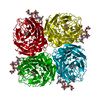 6pzdC 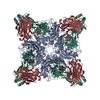 6pzeC 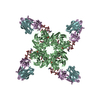 6pzfC 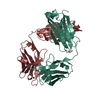 6pzgC 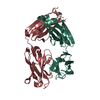 6pzhC  6pzwC  6pzyC  6u02C C: citing same article ( M: atomic model generated by this map |
|---|---|
| Similar structure data |
- Links
Links
| EMDB pages |  EMDB (EBI/PDBe) / EMDB (EBI/PDBe) /  EMDataResource EMDataResource |
|---|---|
| Related items in Molecule of the Month |
- Map
Map
| File |  Download / File: emd_20541.map.gz / Format: CCP4 / Size: 91.1 MB / Type: IMAGE STORED AS FLOATING POINT NUMBER (4 BYTES) Download / File: emd_20541.map.gz / Format: CCP4 / Size: 91.1 MB / Type: IMAGE STORED AS FLOATING POINT NUMBER (4 BYTES) | ||||||||||||||||||||||||||||||||||||||||||||||||||||||||||||||||||||
|---|---|---|---|---|---|---|---|---|---|---|---|---|---|---|---|---|---|---|---|---|---|---|---|---|---|---|---|---|---|---|---|---|---|---|---|---|---|---|---|---|---|---|---|---|---|---|---|---|---|---|---|---|---|---|---|---|---|---|---|---|---|---|---|---|---|---|---|---|---|
| Annotation | CryoEM map of NA-80 Fab in complex with N9 Shanghai | ||||||||||||||||||||||||||||||||||||||||||||||||||||||||||||||||||||
| Projections & slices | Image control
Images are generated by Spider. | ||||||||||||||||||||||||||||||||||||||||||||||||||||||||||||||||||||
| Voxel size | X=Y=Z: 1.03 Å | ||||||||||||||||||||||||||||||||||||||||||||||||||||||||||||||||||||
| Density |
| ||||||||||||||||||||||||||||||||||||||||||||||||||||||||||||||||||||
| Symmetry | Space group: 1 | ||||||||||||||||||||||||||||||||||||||||||||||||||||||||||||||||||||
| Details | EMDB XML:
CCP4 map header:
| ||||||||||||||||||||||||||||||||||||||||||||||||||||||||||||||||||||
-Supplemental data
-Mask #1
| File |  emd_20541_msk_1.map emd_20541_msk_1.map | ||||||||||||
|---|---|---|---|---|---|---|---|---|---|---|---|---|---|
| Projections & Slices |
| ||||||||||||
| Density Histograms |
-Half map: Half map A of CryoEM map of NA-80 Fab in complex with N9 Shanghai
| File | emd_20541_half_map_1.map | ||||||||||||
|---|---|---|---|---|---|---|---|---|---|---|---|---|---|
| Annotation | Half map A of CryoEM map of NA-80 Fab in complex with N9 Shanghai | ||||||||||||
| Projections & Slices |
| ||||||||||||
| Density Histograms |
-Half map: Half map B of CryoEM map of NA-80 Fab in complex with N9 Shanghai
| File | emd_20541_half_map_2.map | ||||||||||||
|---|---|---|---|---|---|---|---|---|---|---|---|---|---|
| Annotation | Half map B of CryoEM map of NA-80 Fab in complex with N9 Shanghai | ||||||||||||
| Projections & Slices |
| ||||||||||||
| Density Histograms |
- Sample components
Sample components
-Entire : NA-80 Fab in complex with N9 Shanghai2
| Entire | Name: NA-80 Fab in complex with N9 Shanghai2 |
|---|---|
| Components |
|
-Supramolecule #1: NA-80 Fab in complex with N9 Shanghai2
| Supramolecule | Name: NA-80 Fab in complex with N9 Shanghai2 / type: complex / ID: 1 / Parent: 0 / Macromolecule list: #1-#3 |
|---|
-Supramolecule #2: N9 Shanghai2
| Supramolecule | Name: N9 Shanghai2 / type: complex / ID: 2 / Parent: 1 / Macromolecule list: #1 |
|---|---|
| Source (natural) | Organism:  Influenza A virus (A/environment/Shanghai/S1439/2013(H7N9)) Influenza A virus (A/environment/Shanghai/S1439/2013(H7N9)) |
-Supramolecule #3: NA-80 Fab
| Supramolecule | Name: NA-80 Fab / type: complex / ID: 3 / Parent: 1 / Macromolecule list: #2-#3 |
|---|---|
| Source (natural) | Organism:  Homo sapiens (human) Homo sapiens (human) |
-Macromolecule #1: Neuraminidase
| Macromolecule | Name: Neuraminidase / type: protein_or_peptide / ID: 1 / Number of copies: 4 / Enantiomer: LEVO / EC number: exo-alpha-sialidase |
|---|---|
| Source (natural) | Organism:  Influenza A virus (A/environment/Shanghai/S1439/2013(H7N9)) Influenza A virus (A/environment/Shanghai/S1439/2013(H7N9))Strain: A/environment/Shanghai/S1439/2013(H7N9) |
| Molecular weight | Theoretical: 48.214508 KDa |
| Recombinant expression | Organism:  |
| Sequence | String: LKPGCNCSHS QPETTNTSQT IINNYYNETN ITNIQMEERT SRNFNNLTKG LCTINSWHIY GKDNAVRIGE SSDVLVTREP YVSCDPDEC RFYALSQGTT IRGKHSNGTI HDRSQYRALI SWPLSSPPTV YNSRVECIGW SSTSCHDGKS RMSICISGPN N NASAVVWY ...String: LKPGCNCSHS QPETTNTSQT IINNYYNETN ITNIQMEERT SRNFNNLTKG LCTINSWHIY GKDNAVRIGE SSDVLVTREP YVSCDPDEC RFYALSQGTT IRGKHSNGTI HDRSQYRALI SWPLSSPPTV YNSRVECIGW SSTSCHDGKS RMSICISGPN N NASAVVWY NRRPVAEINT WARNILRTQE SECVCHNGVC PVVFTDGSAT GPADTRIYYF KEGKILKWES LTGTAKHIEE CS CYGERTG ITCTCRDNWQ GSNRPVIQID PVAMTHTSQY ICSPVLTDNP RPNDPNIGKC NDPYPGNNNN GVKGFSYLDG ANT WLGRTI STASRSGYEM LKVPNALTDD RSKPIQGQTI VLNADWSGYS GSFMDYWAEG DCYRACFYVE LIRGRPKEDK VWWT SNSIV SMCSSTEFLG QWNWPDGAKI EYFL UniProtKB: Neuraminidase |
-Macromolecule #2: NA-80 fragment antibody light chain
| Macromolecule | Name: NA-80 fragment antibody light chain / type: protein_or_peptide / ID: 2 / Number of copies: 4 / Enantiomer: LEVO |
|---|---|
| Source (natural) | Organism:  Homo sapiens (human) Homo sapiens (human) |
| Molecular weight | Theoretical: 23.229693 KDa |
| Recombinant expression | Organism:  Cricetinae gen. sp. (mammal) Cricetinae gen. sp. (mammal) |
| Sequence | String: DIVMTQSPSS LSASVGDRVT ISCRASQSIS SYLNWYQQKP GKAPKLLIYA ASSLQSGVPS RFSGSASGTD FTLTISSLQP EDFATYYCQ QSYSAPFTFG PGTKVDIERT VAAPSVFIFP PSDEQLKSGT ASVVCLLNNF YPREAKVQWK VDNALQSGNS Q ESVTEQDS ...String: DIVMTQSPSS LSASVGDRVT ISCRASQSIS SYLNWYQQKP GKAPKLLIYA ASSLQSGVPS RFSGSASGTD FTLTISSLQP EDFATYYCQ QSYSAPFTFG PGTKVDIERT VAAPSVFIFP PSDEQLKSGT ASVVCLLNNF YPREAKVQWK VDNALQSGNS Q ESVTEQDS KDSTYSLSST LTLSKADYEK HKVYACEVTH QGLSSPVTKS FNRGEC |
-Macromolecule #3: NA-80 fragment antibody heavy chain
| Macromolecule | Name: NA-80 fragment antibody heavy chain / type: protein_or_peptide / ID: 3 / Number of copies: 4 / Enantiomer: LEVO |
|---|---|
| Source (natural) | Organism:  Homo sapiens (human) Homo sapiens (human) |
| Molecular weight | Theoretical: 23.84967 KDa |
| Recombinant expression | Organism:  Cricetinae gen. sp. (mammal) Cricetinae gen. sp. (mammal) |
| Sequence | String: QVQLVQSGAE VKRPGASVKV SCKASGYTFI SYGISWVRQA PGQGLEWMGW ISAYNGNTNY AQNLQGRVTM TTDTSTSTAY MELRSLRSD DTAVYYCARV IPGTAVDYFD YWGQGTLVTV SSASTKGPSV FPLAPSSKST SGGTAALGCL VKDYFPEPVT V SWNSGALT ...String: QVQLVQSGAE VKRPGASVKV SCKASGYTFI SYGISWVRQA PGQGLEWMGW ISAYNGNTNY AQNLQGRVTM TTDTSTSTAY MELRSLRSD DTAVYYCARV IPGTAVDYFD YWGQGTLVTV SSASTKGPSV FPLAPSSKST SGGTAALGCL VKDYFPEPVT V SWNSGALT SGVHTFPAVL QSSGLYSLSS VVTVPSSSLG TQTYICNVNH KPSNTKVDKR VEPKSC |
-Macromolecule #6: 2-acetamido-2-deoxy-beta-D-glucopyranose
| Macromolecule | Name: 2-acetamido-2-deoxy-beta-D-glucopyranose / type: ligand / ID: 6 / Number of copies: 4 / Formula: NAG |
|---|---|
| Molecular weight | Theoretical: 221.208 Da |
| Chemical component information | 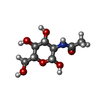 ChemComp-NAG: |
-Experimental details
-Structure determination
| Method | cryo EM |
|---|---|
 Processing Processing | single particle reconstruction |
| Aggregation state | particle |
- Sample preparation
Sample preparation
| Concentration | 0.88 mg/mL |
|---|---|
| Buffer | pH: 7.4 |
| Vitrification | Cryogen name: ETHANE / Instrument: FEI VITROBOT MARK IV |
- Electron microscopy
Electron microscopy
| Microscope | FEI TITAN KRIOS |
|---|---|
| Image recording | Film or detector model: GATAN K2 SUMMIT (4k x 4k) / Detector mode: COUNTING / Average electron dose: 50.0 e/Å2 |
| Electron beam | Acceleration voltage: 300 kV / Electron source:  FIELD EMISSION GUN FIELD EMISSION GUN |
| Electron optics | C2 aperture diameter: 70.0 µm / Illumination mode: FLOOD BEAM / Imaging mode: BRIGHT FIELD / Nominal defocus max: 2.0 µm / Nominal defocus min: 0.8 µm / Nominal magnification: 29000 |
| Sample stage | Specimen holder model: FEI TITAN KRIOS AUTOGRID HOLDER |
| Experimental equipment |  Model: Titan Krios / Image courtesy: FEI Company |
 Movie
Movie Controller
Controller








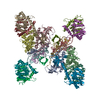


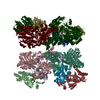

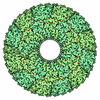
 Z (Sec.)
Z (Sec.) Y (Row.)
Y (Row.) X (Col.)
X (Col.)














